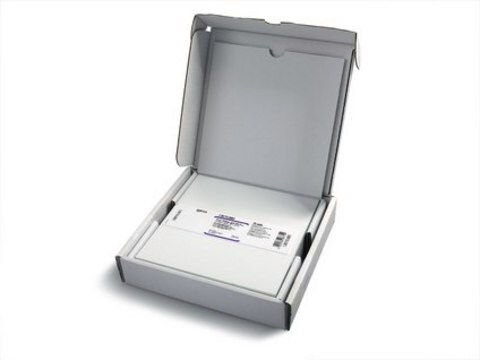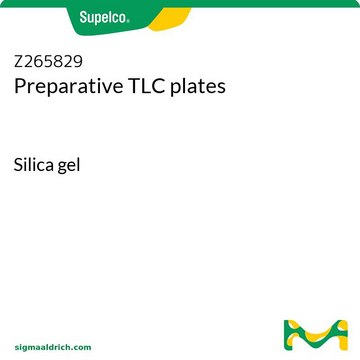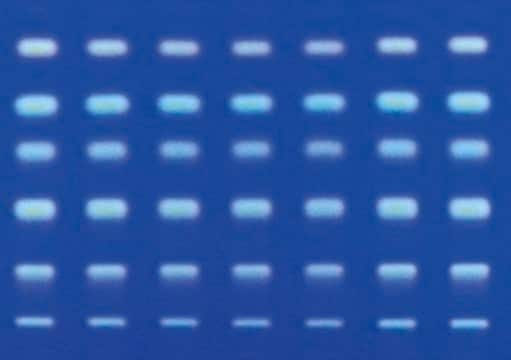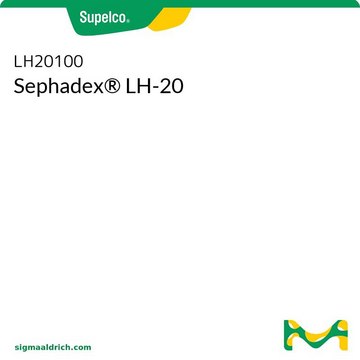1.05744
Plaques pour PLC, Gel de silice 60 F₂₅₄, 0,5 mm
pkg of 20 plates, plate L × W 20 cm × 20 cm, glass support
Synonyme(s) :
High Efficiency Silica gel 60 PLC Plates
About This Item
Produits recommandés
Matériaux
glass support
silica gel 60 matrix
Niveau de qualité
Caractéristiques
binder Organic Polymer
fluorescent indicator
Conditionnement
pkg of 20 plates
Technique(s)
thin layer chromatography (TLC): suitable
Épaisseur de la couche
0.5 mm
Plaque/Plateau, L × l
20 cm × 20 cm
Taille des particules
20-40 μm
Dimension de pores
60 Å medium pore diameter
Température de stockage
2-30°C
Description générale
Application
- An eco-friendly and cost-effective HPTLC method for quantification of COVID-19 antiviral drug and co-administered medications in spiked human plasma: This research developed an environmentally friendly high-performance thin-layer chromatography method to analyze COVID-19 antiviral drugs alongside other medications in human plasma samples, demonstrating effective use of Silica gel 60 F254 plates for clinical applications (Ghozzy et al., 2024).
- Stability indicating high performance thin layer chromatography method development and validation for quantitative determination of tetracycline hydrochloride in active pharmaceutical ingredient (API) and its dosage forms: This study validates a robust HPTLC method using Silica gel 60 F254 plates to determine tetracycline hydrochloride concentrations in pharmaceutical forms, aiding drug stability and quality control (Gashaw et al., 2024).
- Robust high-performance thin-layer chromatography (HPTLC) method for stability assessment and simultaneous quantification of epigallocatechin-3-gallate and rosmarinic acid in lipid-based nanoparticles and biological matrices: This publication discusses a reliable HPTLC technique for analyzing complex biological samples and lipid nanoparticles, highlighting the versatility of Silica gel 60 F254 plates in nanomedicine research (Koli et al., 2024).
- Development and validation of a high-performance thin layer chromatography method for the simultaneous determination of amoxicillin and clavulanic acid combinations in tablet dosage forms: The research introduces a validated HPTLC method for simultaneously detecting amoxicillin and clavulanic acid in tablet forms, utilizing Silica gel 60 F254 plates for pharmaceutical analysis (Asres et al., 2023).
- Simultaneous analysis of the of levamisole with triclabendazole in pharmaceuticals through developing TLC and HPLC-PDA chromatographic techniques and their greenness assessment using GAPI and AGREE methods: This study provides an analytical method using Silica gel 60 F254 plates to analyze levamisole and triclabendazole, assessing the environmental impact of the chromatographic techniques employed (Attia et al., 2023).
Liaison
Remarque sur l'analyse
Tolérance sur l'épaisseur de couche par plaque : ≤ 80 µm
Analyse chromatographique :
Test colorimétrique
Valeurs hRf
- Bleu vif organol, test colorimétrique, lipophile :
17 à 23
- Ceres Black G, dosage colorimétrique, lipophile : 40 à 46
- Ceres violet-brun, dosage colorimétrique, lipophile : 58 à 65
Valeur type déterminée sur plaque préconditionnée
Éluant : toluène (45 % d'humidité relative)
Certificats d'analyse (COA)
Recherchez un Certificats d'analyse (COA) en saisissant le numéro de lot du produit. Les numéros de lot figurent sur l'étiquette du produit après les mots "Lot" ou "Batch".
Déjà en possession de ce produit ?
Retrouvez la documentation relative aux produits que vous avez récemment achetés dans la Bibliothèque de documents.
Les clients ont également consulté
Notre équipe de scientifiques dispose d'une expérience dans tous les secteurs de la recherche, notamment en sciences de la vie, science des matériaux, synthèse chimique, chromatographie, analyse et dans de nombreux autres domaines..
Contacter notre Service technique









